Have you ever felt like we, women are being punished on a monthly basis for not getting pregnant? C’mon think about it, if it’s not period nausea, back pains, mood swings, hellish abdominal cramping, bloating, depression, muscle aches, its breast soreness, and tenderness (because bleeding just isn’t enough, right?)
Symptoms associated with our periods is something we, women have come to accept despite the agonizing discomfort they put us through!
While for some women, sore, tender, aching and heavy breasts is an indicator for when their period will start, for others it lasts throughout the duration of their period.
If you fall into the category of women who experience sore, tender breasts on a monthly basis then you have what is medically referred to as cyclic Mastalgia.
According to the Winchester Hospital health library, some women experience extraordinary sore, tender, lumpy, heavy and sometimes painful breasts associated with their menstrual cycle- cyclic Mastalgia. However, if the lumps become significant then the condition is called fibrocystic breast disease.
Nonetheless, cyclic pain is usually the most frequent pain. While the underlying cause for cyclic Mastalgia is unclear: Some experts claim that the fluctuation of hormones before and during menstrual and the increase of the hormone prolactin are the underlying culprits for breast pain, while others suggest that the soreness during periods are a result of an imbalance of the essential fatty acids.
The pain from this sore is usually felt on both breasts and is sometimes described as heaviness or tenderness that spreads out to the armpit as well as the arms. Additionally, it tends to become more severe before the start of menstruation and gradually subsides after your periods.
Cyclic breast soreness commonly affects young women but usually completely subsides at the start of menopause, whereas non-cyclic case pain also known as fibrocystic breast disease, mostly affects women between the age of 30-50 years and is not associated with the menstrual cycle.
Treatment for sore breasts
- Breast soreness usually goes away on its own without any medical treatment, however, you can use non-prescription pain relief medication such as acetaminophen. Panadol or Tylenol, NSAIDs (nonsteroidal anti-inflammatory drugs) such as naproxen, ibuprofen or aspirin.
- However, if the soreness or pain becomes more severe or continues after you finish bleeding consult your doctor. Additionally, before taking over the counter medication talk to your doctor to know which drugs are good for you and also rule out the occurrence of an allergic reaction from these drugs.
- Also, prescription medicine such as Danazol and tamoxifen citrate are used in cases of severe cyclic Mastalgia. However, these medicines have adverse side effects hence are highly avoided.
- Use of birth control pills also known as oral contraceptives may reduce breast pain during periods, but in some cases, the pain is actually a side effect of oral contraceptives.
- Taking magnesium supplements during your mid-cycle, basically two weeks before your next period can relieve breast soreness.
- Consumption of a very low-fat diet may also offer relief. In some women, reducing the normal amount of caffeine they are used to taking, causes them to experience breast pain.
How to prevent soreness
- Ensure you wear the right sports bra during exercise. Also, make sure your normal bra is the right size for you and fits you perfectly.
- Cut down on caffeinated drinks and salt during your mid-cycle as these two ingredients increase the body’s water retention ability, therefore, worsening the situation.
